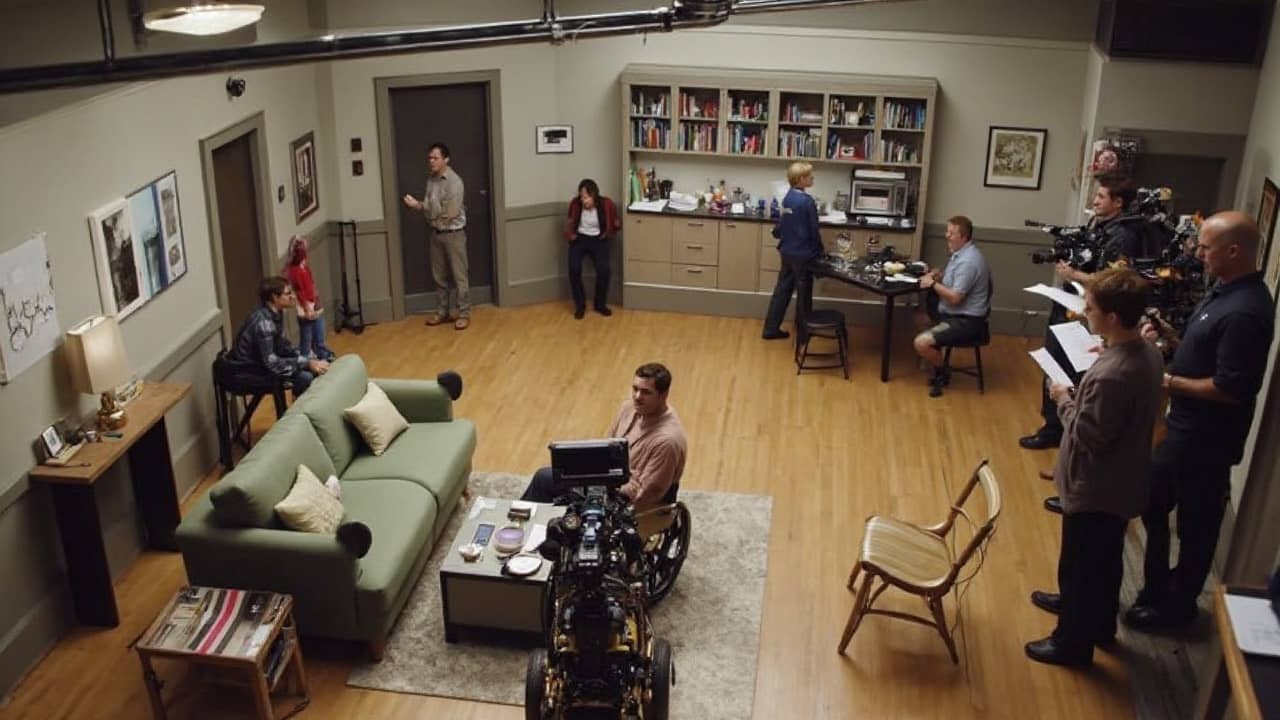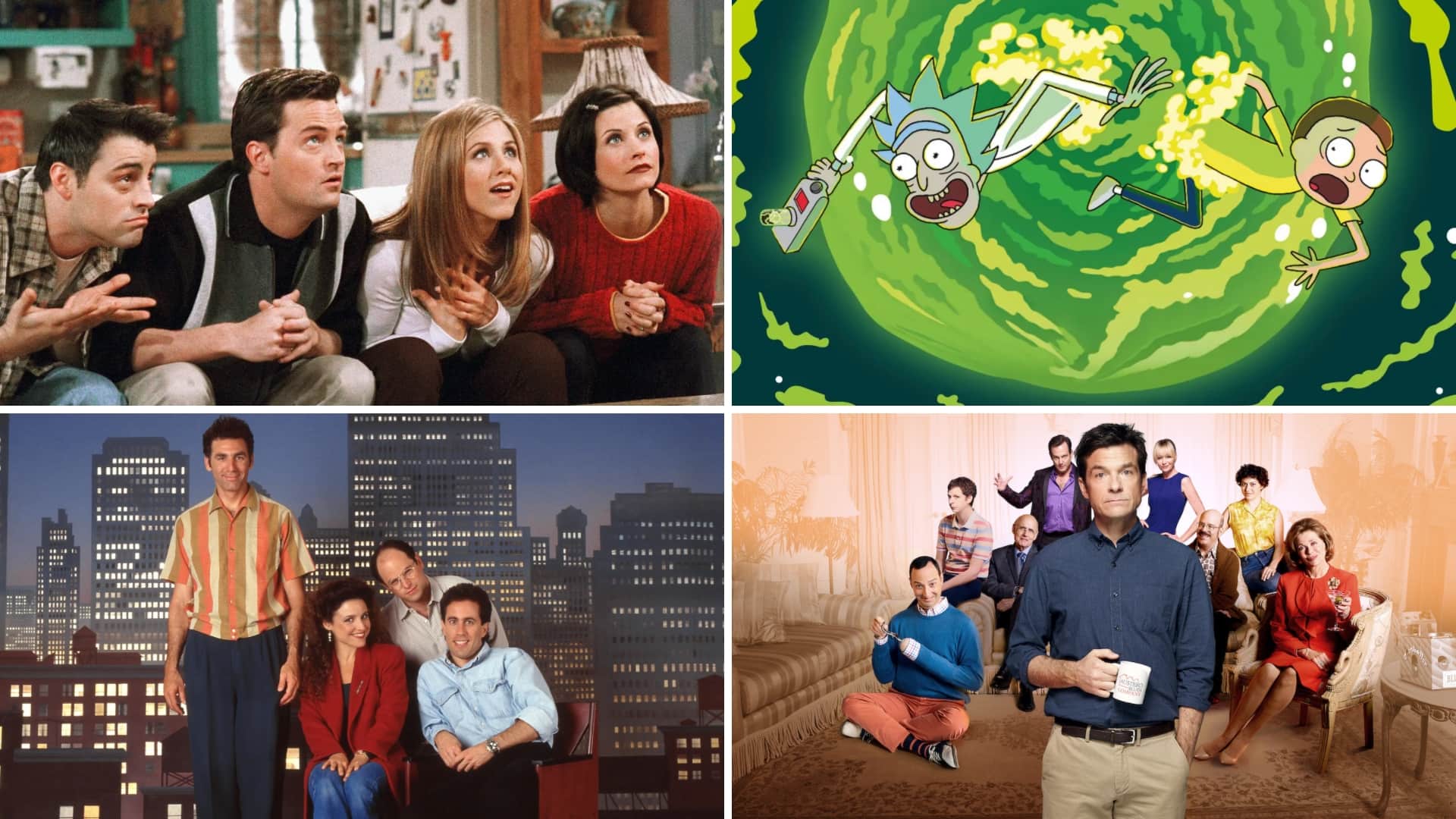What do Always Sunny In Philadelphia, Rick and Morty, Friends, and iCarly all have in common? They’re all sitcoms. The diversity of the genre can be confusing. If The Simpsons and I Love Lucy are both sitcoms, what is a sitcom exactly? In this post, we’ll get into the history of the sitcom and what makes a show a sitcom.
What Is A Sitcom
First, let's define Sitcom
True to the wide array of shows that fall under its category, the sitcom acts as an umbrella term. But don’t think this means that its definition is vague or murky. A sitcom exhibits specific qualities and adheres to a multitude of rules. So, what is a sitcom and what does sitcom stand for?
SITCOM DEFINITION
What is a Sitcom?
A Sitcom is a serialized comedic program where each episode revolves around a different situation. In each different situation, however, there is the same cast of characters who return from episode to episode. Sitcom stands for “situational comedy,” so remember, “comedy sitcoms” is redundant. The history of the sitcom has its roots in radio, with the first sitcoms like Amos ‘n’ Andy cropping up in the medium in the 1920s. Now, however, the term “sitcom” is almost solely used in reference to television shows. The typical sitcom runs anywhere between 20 and 30 minutes.
Famous Sitcom Examples:
- The Simpsons
- 30 Rock
- Arrested Development
- Frasier
- Curb Your Enthusiasm
- Parks and Recreation
- The Mary Tyler Moore Show
- Seinfeld
- Cheers
While unfortunately you’ll have to cross Game of Thrones off your list of top sitcoms, there’s a variety of choices in the genre left to choose from. It’s helpful to look at the many forms the situational comedy can take.
Sitcom Meaning
Types of Sitcoms
While sitcoms all follow a similar structure (more on that later), you might be feeling overwhelmed with the seeming open-endedness of the genre. Now that we have the sitcom definition, let’s narrow down specific subcategories.
THE MULTICAM
The multicam is probably the most instantly recognizable form these shows take, because it has the laugh track. To get these laughs, multicams are shot in front of a live studio audience (though the laughs are almost always augmented in post-production).
Thus, these shows are filmed with multiple cameras, so that the audience doesn’t need to sit through repeated coverage of every scene.

How are sitcoms made? • What is a sitcom?
The live-recorded nature of the multicam gives it a very specific feel. There’s often less subtlety in multicams, since the actors are playing not just to the camera but to the audience.
It’s a unique blend of theater and film. The stage setup also means the locations are limited; at most, you can probably fit four or five settings in a soundstage.
It should also be noted that the multicam can also fall into any of the following categories (save for the animated comedy). The multicam definition refers to form rather than substance.
Examples of the multicam: The Fresh Prince of Bel-Air, The Big Bang Theory, Everybody Loves Raymond, The Dick Van Dyke Show, All in the Family.
THE WORKPLACE COMEDY
Probably the most popular form of sitcom, the workplace comedy has been a go-to for producers since the advent of the medium. By definition, the workplace comedy revolves around — brace yourself — the workplace, and so there’s not many locations needed.
The Office, a modern sitcom not many know about • Sitcom definition
Often, the pitch for a workplace comedy is just the job – “Think of how many jokes we could find in a [paper supply company/bar/parks and rec department/hospital/Korean War hospital]”.
Examples of the workplace comedy: The Office, Parks and Recreation, M*A*S*H, 30 Rock, Brooklyn Nine-Nine, Children’s Hospital, The IT Crowd, The Larry Sanders Show, Taxi.
THE DRAMEDY
The dramedy is probably the least likely to be recognized as a sitcom. When we think of sitcoms, we think of light, silly TV. But there are plenty of dramedies which still count as sitcoms, adhering to all of the genre’s rules.
The main difficulty for dramedy sitcoms is the unchanging aspect of the characters. In situational comedies, we expect each character to be their typical selves at the beginning of each episode. But in drama, we expect to see our characters go through change.
It can be a difficult line to walk without feeling like you’re cheating your audience (“Wait, I thought they already learned that lesson. Why are they doing it again?”), but when it’s done right, the result can be powerful.
Examples of the dramedy: Atlanta, Freaks and Geeks, Bojack Horseman, Fleabag, Louie, Better Things, Insecure.
THE DOMESTIC COMEDY
Almost as popular as the workplace comedy, the domestic comedy is the best medium for relatable, observational comedy. In the domestic comedy, the audience is a fly-on-the-wall as beloved characters go about their day, navigating friends, family, and romance.
The domestic comedy can provide comfort food: what’s more relaxing than seeing Monica and Rachel’s apartment? But it can also be just as cutting as the dramedy (e.g. All in the Family).
Examples of the domestic comedy: Modern Family, How I Met Your Mother, New Girl, Friends, Seinfeld, Sanford and Son, Catastrophe, The Odd Couple, The Jeffersons.
THE ANIMATED COMEDY
Pretty self-explanatory here. The beauty of the animated sitcom is that it can buck the creative limitations of live-action counterparts. Think of Rick and Morty’s countless intergalactic odysseys, or a gag as small Homer wringing Bart’s neck. That said: for all their experimentation, they abide by the basic rules of the sitcom. Yes, even Rick and Morty.
Examples of the animated comedy: Futurama, Family Guy, South Park, Rick and Morty, Tuca and Bertie, Bob’s Burgers.
Related Posts
Sitcom Meaning
Structure of a Sitcom
Now that we’ve gone through all the types (well, not all, but a lot), let’s figure out what links all of these sitcom examples together.
First, check out this great explainer video, which walks us through the common beats that you’ll see in most shows:
The Sitcom Definition • What is a sitcom?
Note that the video is using a clock that only goes until the thirty minute mark. That’s the first rule of a sitcom: it shouldn’t be over thirty minutes long. For lots of American TV, this holds true with advertising included, which means that lots of US shows aren’t more than 25 minutes.
The second takeaway of this video is that the plot points it describes are essentially reworded Save the Cat beats. Most sitcoms follow that iconic Hollywood movie structure, just sped up.
There are two crucial differences. First, unlike a film, a sitcom doesn’t need to waste much time setting up its characters since they’re recurring. Second, the characters and their circumstances cannot be significantly altered by the end of the episode. To do so would blow up the repetitive rhythm of the genre.
There are rare occasions where this rule is ignored (e.g. Jim and Pam getting married). But they’re rare for a reason — it can be dangerous for a show to permanently alter its chemistry. If it ain’t broke, don’t fix it.
So, with that in mind, let’s do a Save the Cat breakdown of an episode from It’s Always Sunny In Philadelphia, the longest running single-cam sitcom in history. We’ll use “The Gang Dines Out,” which contains one of the funniest two shots ever put to tape:

What does sitcom mean • Sitcom meaning
What is a sitcom? The structure of “The Gang Dines Out”:
Exposition: Dennis and Mac are eating out at a classy restaurant.
Inciting Incident: Dennis and Mac see Frank and Charlie enter the restaurant.
Break into Act 2: Dee’s also there. The entire gang is eating in the same place.
Rising Action: Each table gets more and more furious that the other isn’t “paying tribute.”
Midpoint: Frank gets Charlie on his side. The war is on.
Break into Act 3: After Dennis sings to Mac, Mac is on Dennis’s side, and they’re about to get into a brawl with Charlie and Frank.
Climax: The waiter tries to stop them, but collides into another waiter.
Finale: They all laugh at the waiter and able to put their differences aside.
Seems easy, doesn’t it? Luckily, though, a great sitcom isn’t just one that knows structure. A great sitcom has to ring true to an audience, have indelible characters, and, most of all, be funny.
Watch this instructive interview with Ricky Gervais, who wrote one of the greatest sitcoms of all time, The Office:
Ricky Gervais on writing • What is sitcom genre?
At this point, you’re probably drowning in advice and structure. Don’t overthink it: if it’s good, it should feel natural.
Up Next
What is Satire?
Now that you’ve answered the age-old questions “What is a sitcom?” and “What does sitcom mean?” it’s time to focus on the com part of the equation. One of the most potent forms of comedy is satire, a tool for critiquing elements of society with a biting grin. We go through its three types, what they are, and how they work.
Up Next: Satire Explained →
Showcase your vision with elegant shot lists and storyboards.
Create robust and customizable shot lists. Upload images to make storyboards and slideshows.
